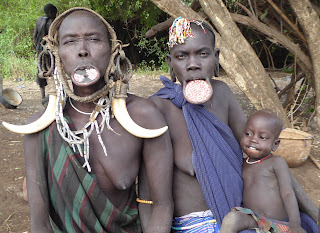the Mursi - lip plates, blood and scars
I've long dreamed of seeing the Mursi tribe of Ethiopia's Omo Valley, although have been warned that it has become a human zoo, with any visitors surrounded by lip plate-wearing women demanding money for photos. But I still wanted to go - wanted to see these women with my own eyes - to see a tradition that will surely disappear before long.
As I made the long journey down to the Omo Valley, with a tour organised by a Spanish company (Last Places) that like to go a little deeper into the cultures of the tribes they visit, it was clear that only a limited number of people would make such a journey. Whilst only some 500km from the capital, I believe, it is a journey of two long days' driving, much of it unsurfaced dirt tracks, all of it slowed considerably by the flocks of cows and goats being herded along those roads, the donkey carts, and indeed the random goats who have just decided that the road is a comfortable place to take a rest and who are not going to move just because a vehicle is hooting at them.
But we arrived, eventually, exhausted from the trip and glad to be with a tour group whose leader negotiated a group fee to the village chief so as to avoid the 'per photo' fee hassle, and who included in their negotiations our overnight camp and our access to a number of activities within the community.
So we took plenty of photos, two people bought lip plates as souvenirs, and we went to bed quite early, ready for a sunrise trek out to the cattle camp to see the first community activity.
This involved a one-hour walk through very muddy fields to one of the community cattle camps - a place where the cattle stay and where those charged with looking after them have to sleep. Here, each morning, an animal is selected and a belt tied around its neck, tightly enough to make the jugular bulge. An arrow is fired from close range into the jugular, and a calabash used to collect the spouting blood. Around two litres was collected, then the wound to the animal was sealed with mud and the blood passed to a young tribe member to drink - it makes up an important nutritional part of the diet.We tourists were invited to drink some of the blood, and of course I jumped at the opportunity! It was warm, thick, rich, very obviously high in iron, and without too many lumps, thankfully!
The other community activity we were invited to watch also involved blood, although this time human and just a by-product. All of the women and some of the men had many scars adorning their bodies, and we were able to watch the production of one such scar on an adolescent girl.
The design was drawn on, and then cut into the skin with a razor blade (this modern implement presumably replacing more traditional ones such as sharp stones?). After a short wait, during which no-one seemed at all concerned by the flies feasting on her wound, it was wiped clean and sealed with mud. The girl sat there impassively throughout the process, with no visible sign that she felt any pain at all.Some of the the villagers then tried again to sell us lip plates and jewellery (I found a discarded unpainted small lip plate on the edge of the village - almost cetainly discarded as its owner progressed to a larger size - so I'm happy that mine is 'authentic'!), until finally we packed up to move on to our next destination.
Yes, it was touristy. You cannot get away from the fact that we have paid to be there and are gawking at the villagers - at their scars, their lips, their jewellery - and taking pictures almost as it they are zoo exhibits.
There is little real (non-commercial) interaction between the tourists and the villagers, although when I got my binoculars out to look at a bird on a tree-top, a few young villagers came and excitedly looked through them. The closest I got to feeling any connection, however, was when I asked a young lady through sign language why she didn't wear a lip plate (after she'd just happily posed for me to photograph the scars on her arm). Her expression and corresponding shudder transcended language and culture! I'm not sure whether she was referring to the pain that must be involved in the procedure (including the removal of two lower front teeth to make the necessary space), or of how unattractive it is to see the lip hanging loose when they don't want to wear the plate ... but either way, I could empathise!









Comments
Post a Comment